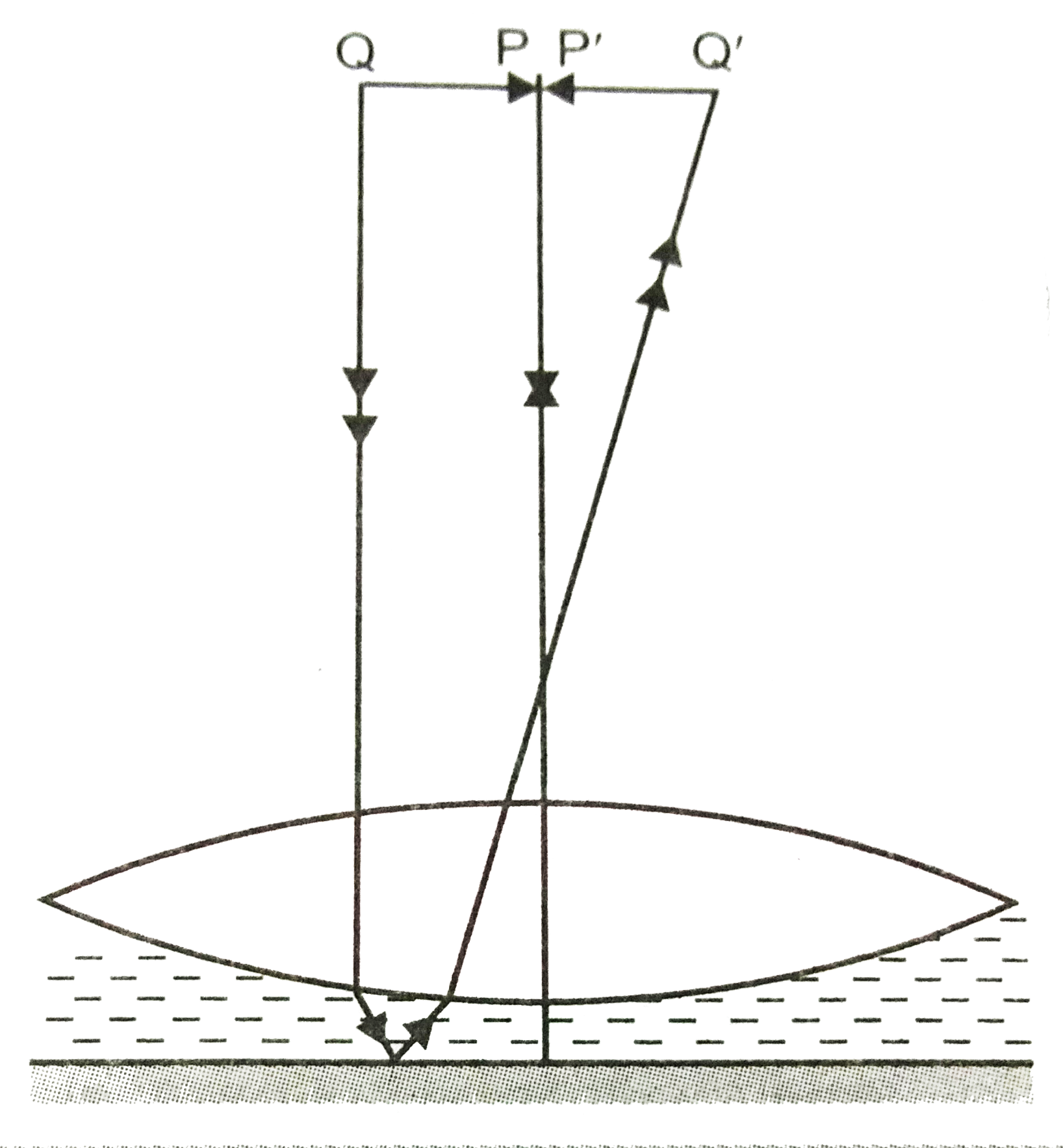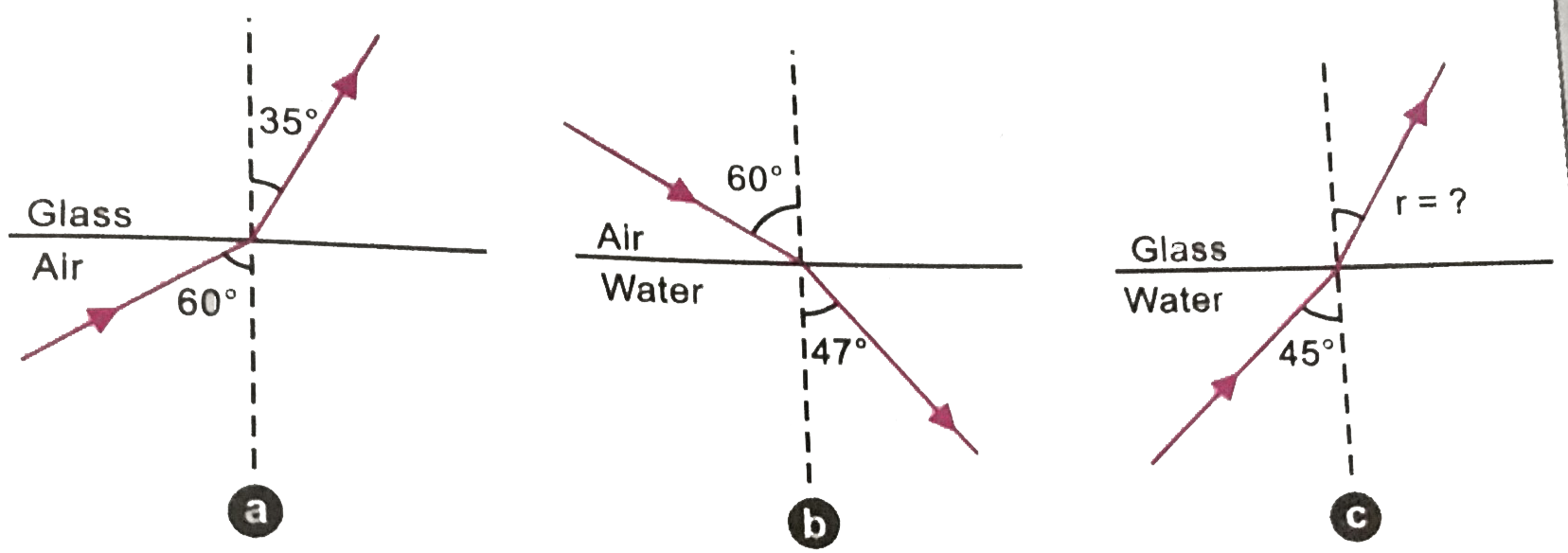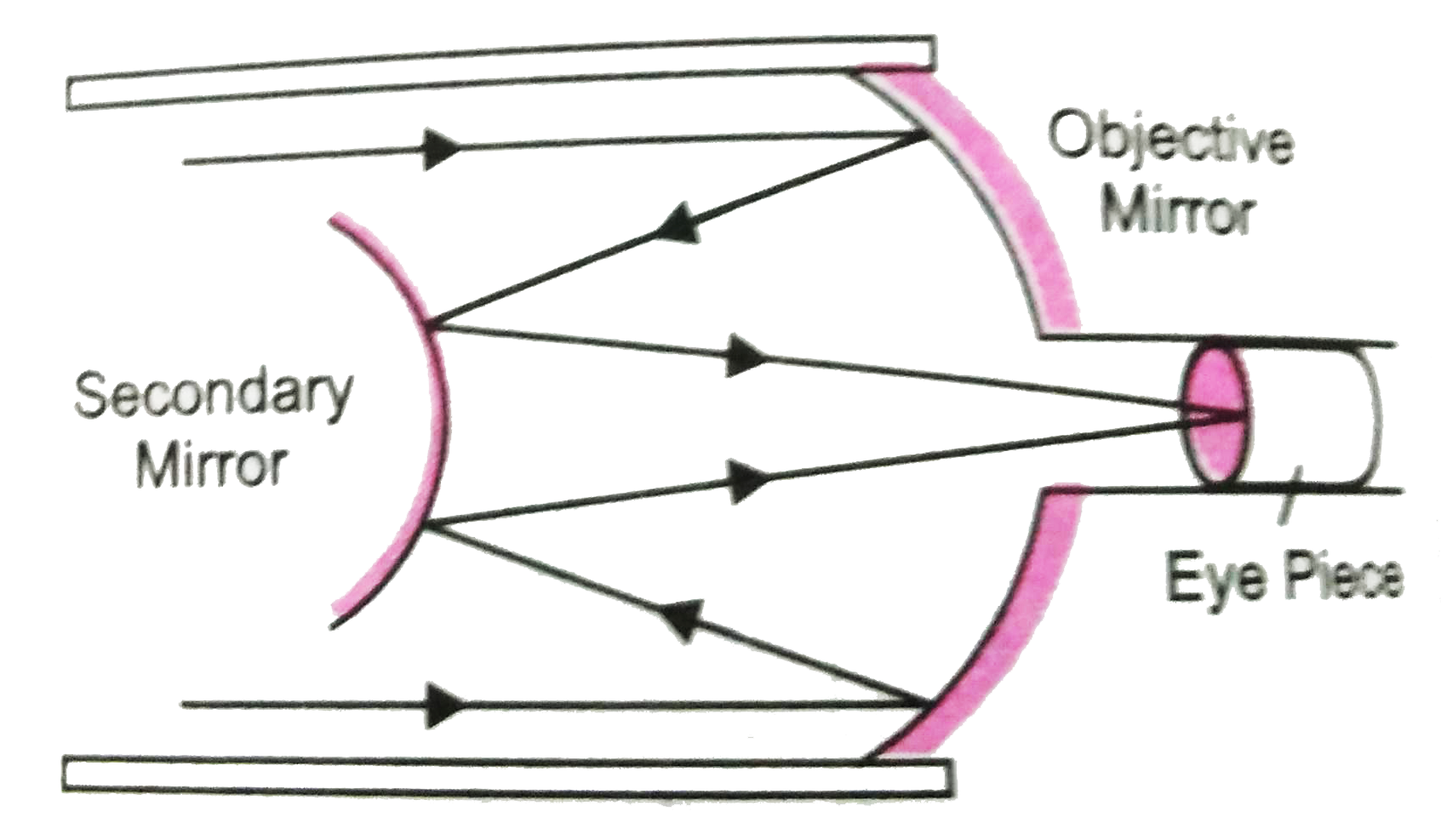NCERT FILE SOLVED (TEXT BOOK EXERCISES) from MODERN PUBLISHERS PHYSICS Chapter 104 RAY OPTICS AND OPTICAL INSTRUMENTS for Class 12
| Class 12 | PHYSICS |
| Chapter | RAY OPTICS AND OPTICAL INSTRUMENTS |
| MODERN PUBLISHERS PHYSICS | NCERT FILE SOLVED (TEXT BOOK EXERCISES) |
| Medium | English |
| Academic Year | 2023-2024 |
Question 1
A small candle 2.5cm in size is placed 27cm in front of a concave mirror of radius of curvature 36cm. At what distance from the mirror should a screen be placed in order to receive a sharp image ? Describe the nature and size of the image. If the candle is moved closer to the mirror, how would the screen have to be moved ?View SolutionQuestion 3
A tank is filled with water to a height of 12.5cm. The apparent depth of a needle lying at the bottom of the tank is measured by a microscope to be 9.4cm. What is the refractive index of water ? If water is replaced by a liquid of refractive index 1.63 upto the same height, by what distance would the microscope have to be moved to focus on the needle again ?View SolutionQuestion 6
A prism is made of glass of unknown refractive index. A parallel beam of light is incident on a face of the prism. The angle of minimum deviation is measured to be 40∘. What is the refractive index of the material of the prism? The refracting angle of the prism is 606∘. If the prism is placed in water (refractive idex 1.33), predict the new angle of minimum deviation of a parallel beam of light. View SolutionQuestion 11
A compound micrscope consists of an objective of focal length 1.0 cm and an eyepiece of focal length 5.0 cm separated by 12.2 c.a. At wht distance from the objective should a object be placed to focus it prope4y so that the final image is formed at the least distance of clear vision (25cm)? b. calculate the angular magnificationn in this case.View SolutionQuestion 12
A person with a normal near point (25cm) using a compound microscope with an objective of focal length 8.0mm and eye piece of focal length 2.5cm can bring an object placed 9.0cm from the objective in sharp focus. What is the separation between the two lenses ? Calculate the magnifying power of the microscope ?View SolutionQuestion 14
(a) A giant refracting telescope at an observatory has an objective lens of focal length 15 m. If an eyepiece of focal length 1.0 cm is used, what is the angular magnification of the telescope?
(b) If this telescope is used to view the Moon, what is the diameter of the image of the Moon formed by the objective lens? The diameter of the Moon is 3.48×106m and the radius of lunar orbit is 3.8×106m.View SolutionQuestion 15
Use the mirror equation to deduct that :
(a) an object between f and 2f of a concave mirror produces a real image beyond 2f.
(b) a convax mirror always produces a virtual image independent of the location of the object.
( c) the virtual image produced by a convex mirror is always diminished in size and is located between the focus and the pole.
(d) an object placed between the pole and focus of a concave mirror produces a virtual and enlarged image.View SolutionQuestion 16
A small pin fixed on a table top is viewed from above from a distance of 50cm. By what distance would the pin appear to be raised, if it be viewed from the same point through a 15cm. Thick glass slab held parallel to the table? μ of glass is 1.5. Does the answer depend on location of the slab ?View SolutionQuestion 17
(a) Fig. shows a cross-section of a 'light pipe' made of a glass fibre of refractive index 1.68. The outer covering of the pipe is made of a material of refractive index 1.44. What is the axis of the pipe for which total reflection inside the pipe take place as shwon.
(b) What is the answer if there is no outer covering if the pipe ?
 View Solution
View SolutionQuestion 21
a) Determine the effective focal length of the combination of the two lenses in Exercise, if they are placed 8.0cm apart with their principal axes coincident. Does the answer depend on which side of the combination a beam of paralel light is incident? Is the notions of effective focal length of this system useful at all?
b) An object 1.5 cm in size is placed on the side of the convex lens in the arrangement a) above. The distance between the object and the convex lens is 40cm. Determine the magnification produced by the two-lens system, and the size of the image. View SolutionQuestion 24
For a normal eye, the far point is at infinity and the near point of distinct vision is about 25cm in front of the eye. The cornea of the provides a converging power of about 40dioptre and the least converging power of eye lens behind the cornea is about 20dioptre. From this rough data, estimate the range of accommodation (i.e., the range of converging power of the eye lens) of a normal eye.View SolutionQuestion 28
A man with normal near point (25 cm) reads a book with small print using a magnifying glass : a thin convex lens of focal length 5cm.
answer of the following question (a) What are the closest and the farthest distances at which he can read the book when viewing through the magnifying glass ?
(b) What is the maximum and the minimum angular magnifications (magnifying powers) possible using the above simple microscope ?View SolutionQuestion 29
A cardsheet divided into squares each of size 1mm2 is being viewed at a distance of 9cm through a magnifying glass (a conerging lens of focal length 10cm) held close to the eye.
(a) What is the magnification produced by the lenas ? How much is the area of each square to the virtual image ?
(b) What is the angular magnification (magnifying power) of the lens ?
( c) Is the magnification in (a) equal to the magnifying power in (b) ? ExplainView SolutionQuestion 32
a) The anlge subtended at the eye by an object is equal to the angle subtended at the eye by the virtual image produced by a magnifying glass. In what sense then does a magnifying glass provide angular magnifications?
b) in viewing through a magnifying glass, one usually positions one's eyes very close to the lens. Does angular magnification change if the eye is moved back?
c) magnifying power of a simple microscopes is inversely proportional to the focal length of the lens. What then stops us from using a convex lens of smaller and smaller focal length and achieving greater and greater magnifying power?
d) Why must both the objective and the eyepiece of a compound microscope have short focal lengths?
e) When viewing through a compound microscope, our eyes should be positioned not on the eyepiece but a short distance away from it fot best veiwing. Why? How much should be that short distance between the eye and eyepiece?View SolutionQuestion 34
A small telescope has an objective lens of focal length 140 cm and an eyepiece of focal length 5.0 cm. what is the magnifying power of the telescope for viewing distant objects when
(a) the telescope is in normal adjustment (i.e, when the final image is at infinity ),
(b) The final image is formed at the least distance of distinct vision (25 cm ) View SolutionQuestion 35
(a) For the telescope described what is the separation between the objective lens and eye piece ?
(b) If this telescope is used to view a 100m tall tower 3km away, what is the height of the image of the tower formed by the objective lens ?
(c ) What is the height of the final image of the tower if it is formed at 25 cm ?View SolutionQuestion 38
Fig. shows an equiconvex lens (of refractive index 1.5) in contact with a liquid layer on top of a plane mirror. A small needle with its tip on the principal axis is moved along the axis until its inverted image is found at the position of the needle. The distance of the needle from the lens is measured to be 45.0cm. The liquid is removed and the experiment is repeated. The new distance is measured to be 30.0cm. What is the refractive index of the liquid ?
 View Solution
View Solution
All Exercises from MODERN PUBLISHERS PHYSICS Class 12 PHYSICS RAY OPTICS AND OPTICAL INSTRUMENTS
- CHAPTER PRACTICE TEST
- Conceptual Questions
- Higher Order Thinking Skills & Advanced Level (QUESTIONS WITH ANSWERS)
- NCERT (EXemplar Problems Obejective Questions) (Multiple Choice Questions (Type-I)
- NCERT (EXemplar Problems Obejective Questions) (Multiple Choice Questions (Type-II)
- NCERT (Exemplar Problems Subjective Questions) (Very Short Answer Type Questions)
- NCERT FILE SOLVED (TEXT BOOK EXERCISES)
- OBJECTIVE TYPE QUESTIONS (A. MULTIPLE CHOICE QUESTIONS)
- OBJECTIVE TYPE QUESTIONS (ASSERTION REASON TYPE QUESTIONS)
- OBJECTIVE TYPE QUESTIONS (B. MULTIPLE CHOICE QUESTIONS)
- OBJECTIVE TYPE QUESTIONS (C. MULTIPLE CHOICE QUESTIONS)
- OBJECTIVE TYPE QUESTIONS (D. MULTIPLE CHOICE QUESTIONS)
- OBJECTIVE TYPE QUESTIONS (INTEGER TYPE QUESTIONS)
- OBJECTIVE TYPE QUESTIONS (JEE (ADVANCED) FOR IIT ENTRANCE)
- OBJECTIVE TYPE QUESTIONS (JEE (MAIN) & OTHER STATE BOARDS FOR ENGINEERING ENTRANCE)
- OBJECTIVE TYPE QUESTIONS (MATCHING TYPE QUESTIONS)
- OBJECTIVE TYPE QUESTIONS (MATRIX MATCH TYPE QUESTIONS)
- PRACTICE PROBLEMS (1)
- PRACTICE PROBLEMS (10)
- PRACTICE PROBLEMS (11)
- PRACTICE PROBLEMS (2)
- PRACTICE PROBLEMS (3)
- PRACTICE PROBLEMS (4)
- PRACTICE PROBLEMS (5)
- PRACTICE PROBLEMS (6)
- PRACTICE PROBLEMS (7)
- PRACTICE PROBLEMS (8)
- PRACTICE PROBLEMS (9)
- Revision Exercises (Additional Questions)
- Revision Exercises (Fill in the Blanks)
- Revision Exercises (Long Answer Questions)
- Revision Exercises (Numerical Problems)
- Revision Exercises (Short Answer Questions)
- Revision Exercises (Very Short Answer Questions)
- SOLVED EXAMPLES
- Tough & Tricky (PROBLEMS)
 .
.